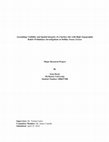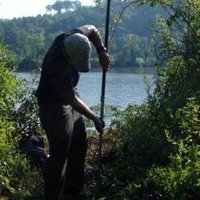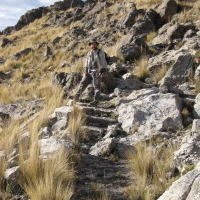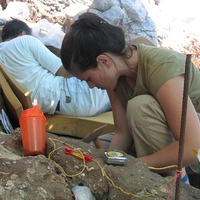Papers by Sean Doyle
The Stélida Naxos Archaeological Project: new data on the Middle Palaeolithic and Mesolithic Cyclades
Antiquity, 2014
This article introduces new work at Stélida on the north-west coast of Naxos (Cycladic Islands, G... more This article introduces new work at Stélida on the north-west coast of Naxos (Cycladic Islands, Greece), a source of chert that we demonstrate to have been used extensively in the Middle Palaeolithic and Mesolithic periods.
partie 1 / Part 1 21 anthropisation et mutations paysagères à la transition paléolithique/Néolith... more partie 1 / Part 1 21 anthropisation et mutations paysagères à la transition paléolithique/Néolithique anthropization and landscape changes during the Late Paleolithic/Neolithic transition la diffusion du néolithique en Méditerranée 23 GUilaine Jean late pleistocene to early holocene sea-crossings in the aegean: direct, indirect and controversial evidence 33 papoUlia christina Variations relatives du niveau moyen de la mer en corse au cours des 6 000 dernières années 97 Vacchi Matteo, Ghilardi Matthieu, cUrrÁs andrés reconstructing the coastal configuration of lemnos island (northeast aegean sea, Greece) since the last Glacial Maximum 109 chalKioTi areti holocene sea level changes and palaeogeographic reconstruction of the ayia irini prehistoric settlement (Keos island, cyclades archipelago, Greece) 119 MoUrTzas nikos, KolaiTi eleni
The Stélida Naxos Archaeological Project: New data on the Mesolithic and Middle Palaeolithic Cyclades
Posters by Sean Doyle

This paper presents the results of a goat butchering experiment conducted in July 2016 at Çatalhö... more This paper presents the results of a goat butchering experiment conducted in July 2016 at Çatalhöyük (Turkey). The experiment was purely exploratory, as it was our first time butchering a goat and professional butchers were not involved. Our main goal was to establish a baseline for what it takes to butcher a goat with minimal effort; how many tools were involved, which motions were employed, how long each task would take, etc. Our research objective was to determine how much use-wear would accumulate after specific short-term actions, and so we used a different obsidian tool for every stage of the butchery process.
The flakes used for the experiment were knapped on site by direct percussion with a soft stone hammer, and the blades produced via pressure applied using a chest crutch with an antler tip. The raw material used was obsidian from Göllü Dağ, a source in Cappadocia that was commonly used by the inhabitants of Çatalhöyük.
The experiment started with the removal of the hide and viscera. The goat was then dismembered, and finally the rib cage was separated. Once the goat had been butchered, the hide was left to soak in a mixture of water and wood ash for two days. Afterwards, two scrapers made on thick overshot blade core platform rejuvena¬tion flakes were used to scrape off the fat and other material. Finally, the entire carcass was buried in order to let the flesh decompose naturally.
As it was an exploratory experiment, we did not give any recommendations to the volunteer butchers. They each chose their own tools from a selection and decided how best to use them. We documented and made detailed descriptions of all the activities. Provil© casts were taken before and after use, and the entire experiment was photographed and most of it filmed.
Thesis Chapters by Sean Doyle

Unpublished Master's Thesis - McMaster University, 2018
Archaeologists use the remains of cultural material that have accumulated on or near Earth’s surf... more Archaeologists use the remains of cultural material that have accumulated on or near Earth’s surface as direct proxies to human behaviour in the past. In this paper I develop a methodology to assess the spatial integrity of a surface assemblage from the slopes of Stélida, Naxos, Greece, and identify areas of primary cultural material deposition. The artifacts in question were collected as part of a surface survey undertaken by the Stélida Naxos Archaeological Project from 2013–2014. My multi-scalar analyses were first aimed at interrogating the site as a whole, using quantities and weights of the assemblage organized into three size categories (<2cm, 2-10cm, and >10cm), followed by a more intensive analysis on a topographically representative area of the hill. In this second stage I measured a sample of artifacts three dimensionally as a means of generating an index of sphericity, which is primarily determined by the state of the artifact when it was first produced. Some rounding of the edges and breaks can occur over time through various taphonomic processes, which can affect an artifact’s morphology, but generally the level of sphericity is only minimally altered. I then correlated this sphericity value against the type and amount of post-depositional damage, consisting of fresh edge scars and snaps accrued not as part of the production and use of the artifacts but as a result of taphonomic processes, on each sample using a series of basic logistic regressions. These methods produced two conclusions: 1) as sphericity increases, the probability of any fresh edge scars occurring increases, and the average number of scars increases; and 2) as sphericity decreases, the probability of the artifact being snapped increases. These conclusions formed a baseline for the state of the surface material on Stélida, which I then compared to the slope angles and vegetation coverage to identify collection points of which the spatial integrity of their assemblages has remained relatively intact since their time of deposition. This study was ultimately successful and determines that similar research on a larger scale would be beneficial to the project, both to identify areas of primary cultural deposition and thus loci where excavation trenches could be placed in order to maximize the probability of finding intact subsurface deposits.
Keywords: Archaeological survey; Lithics; Post-depositional damage; Site-formation processes; Spatial integrity; Surface assemblage









Uploads
Papers by Sean Doyle
Posters by Sean Doyle
The flakes used for the experiment were knapped on site by direct percussion with a soft stone hammer, and the blades produced via pressure applied using a chest crutch with an antler tip. The raw material used was obsidian from Göllü Dağ, a source in Cappadocia that was commonly used by the inhabitants of Çatalhöyük.
The experiment started with the removal of the hide and viscera. The goat was then dismembered, and finally the rib cage was separated. Once the goat had been butchered, the hide was left to soak in a mixture of water and wood ash for two days. Afterwards, two scrapers made on thick overshot blade core platform rejuvena¬tion flakes were used to scrape off the fat and other material. Finally, the entire carcass was buried in order to let the flesh decompose naturally.
As it was an exploratory experiment, we did not give any recommendations to the volunteer butchers. They each chose their own tools from a selection and decided how best to use them. We documented and made detailed descriptions of all the activities. Provil© casts were taken before and after use, and the entire experiment was photographed and most of it filmed.
Thesis Chapters by Sean Doyle
Keywords: Archaeological survey; Lithics; Post-depositional damage; Site-formation processes; Spatial integrity; Surface assemblage
The flakes used for the experiment were knapped on site by direct percussion with a soft stone hammer, and the blades produced via pressure applied using a chest crutch with an antler tip. The raw material used was obsidian from Göllü Dağ, a source in Cappadocia that was commonly used by the inhabitants of Çatalhöyük.
The experiment started with the removal of the hide and viscera. The goat was then dismembered, and finally the rib cage was separated. Once the goat had been butchered, the hide was left to soak in a mixture of water and wood ash for two days. Afterwards, two scrapers made on thick overshot blade core platform rejuvena¬tion flakes were used to scrape off the fat and other material. Finally, the entire carcass was buried in order to let the flesh decompose naturally.
As it was an exploratory experiment, we did not give any recommendations to the volunteer butchers. They each chose their own tools from a selection and decided how best to use them. We documented and made detailed descriptions of all the activities. Provil© casts were taken before and after use, and the entire experiment was photographed and most of it filmed.
Keywords: Archaeological survey; Lithics; Post-depositional damage; Site-formation processes; Spatial integrity; Surface assemblage